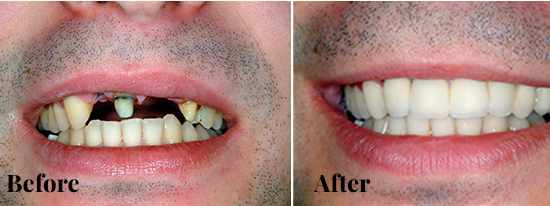Unfortunately, tooth loss is common and can lead to a variety of additional oral and overall health issues. If you are missing one or more teeth, you may want to consider a dental bridge as a permanent tooth replacement option. At Peak Dental Group, we understand that missing teeth can impact your confidence. Therefore, we look forward to working with our patients to replace missing teeth and restore smiles and confidence.


A traditional bridge attaches to natural teeth with crowns and may be rigid or may have some flexibility. A rigid bridge requires that the neighboring teeth be parallel, but the flexible option does allow for some deviation. The dental team will determine which is best for you during your consultation.
A cantilever bridge is ideal for patients with teeth on only one side of the gap. This type of dental bridge is not as common as it used to be.
A Maryland bridge does not require crowns to be placed on neighboring teeth but has wings that attach instead. This type of bridge requires less preparation and is typically used on the front teeth. This procedure is less invasive but is not as secure as a traditional bridge.
An implant-supported bridge is like a traditional bridge but uses implants for support instead of crowns placed on natural teeth.
For patients who are missing multiple teeth, dental bridges can help. This tooth restoration option supports one or more teeth, anchored to dental implants or crowns on the natural teeth on each side of the gap. There are several benefits associated with dental crowns, including:
If your smile makes you feel self-conscious or you’ve ever tried to hide your smile in photos, a dental bridge may help. Research shows that dental bridges can restore your smile and improve your quality of life.
When you are missing teeth, you may have difficulty or sensitivity when eating your favorite foods. This is often due to the neighboring teeth shifting into the open space. In addition, food particles may collect in the empty socket, resulting in gum damage. A dental bridge can alleviate these issues.
Your teeth play a major role in your speaking ability. When you’re missing teeth, you may struggle to pronounce some words and may even develop a lisp. In order to address this issue, you must replace the missing teeth. A dental bridge may be a more natural-looking, cost-effective way to do that.
Once you lose a tooth, your jawbone begins to deteriorate. After all, if you don’t use it, you’ll lose it. Jawbone deterioration can result in additional teeth falling out and ultimately impact your facial shape. A dental bridge, especially an implant-supported bridge, can help support your facial shape.
You know that the roots of your teeth go into the jawbone, holding them in place- but they are also held in place by neighboring teeth. When you start losing teeth, the rest of your teeth start to shift to fill in the gap, which may cause them to become loose and fall out, making the problem worse. The best way to prevent this shifting is with prosthetic teeth.
The procedure for getting a dental bridge varies slightly depending on the type of bridge you are getting. However, regardless of the type of dental bridge you get, you’ll need at least 2 appointments. Since Maryland bridges don’t require abutment teeth to be modified, you don’t need as many appointments. Impressions are required for all 4 types of dental bridges.
If you are getting a traditional or cantilever bridge, the first step is to prep the abutment tooth/teeth. We will start by removing some of the enamel and dentin to make room for the crown. A temporary crown will be placed until your bridge is ready.
Once the bridge has been fabricated, the temporary crowns will be removed, and the bridge will be checked to ensure that it fits properly. If it looks/feels good, we will cement it in place.
The only tooth preparation required for a Maryland bridge is some minor etching on the back of the abutment teeth. This will allow the wings to adhere. Before securing the bridge, we will check for proper fit.
Implant-supported bridges require the most appointments because the implants must be placed. This process can take several months to complete, but you will be given a temporary bridge while you heal. Once healing is complete, the permanent bridge can be placed. Your natural teeth are not impacted by an implant-supported bridge.
Before dental bridges, patients often struggle with eating, and speaking, and may even have pain and other oral health issues. However, after getting a dental bridge, these problems are often resolved.



Dr. Lana Huynh, Dr. Sammy Gill, and Dr. Gurshant Grewal make up the dental team at Peak Dental Group in Calgary. They strive to make sure that their patients are comfortable and understand the procedures before any work will be done. We believe that dental visits should be a pleasant experience.
If you are missing one or more teeth and believe that a dental bridge may be an option for you, schedule your consultation with the team at Peak Dental Group today. We are located on Nolanridge Court, NW. Our office hours are Monday through Friday, 9:00 AM to 5:00 PM. We look forward to working with you to restore your missing teeth and improve your smile and your confidence!

Patients at Peak Dental Group in Calgary often have questions about our dental procedures. Some of the most common questions we hear about dental bridges include:



